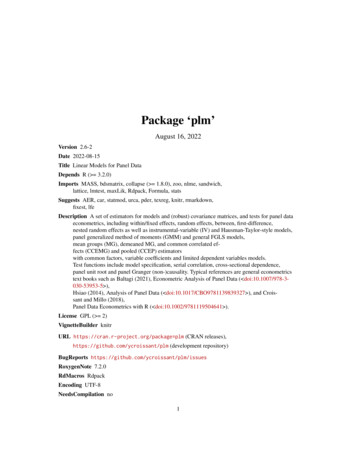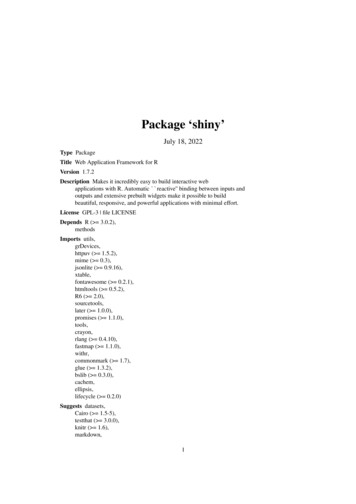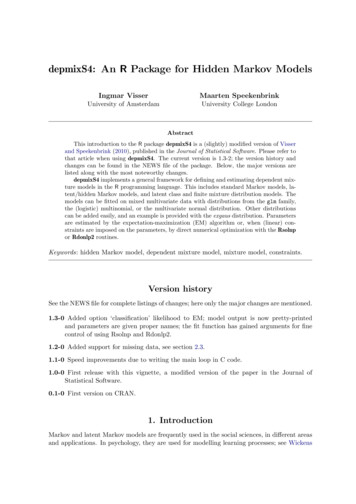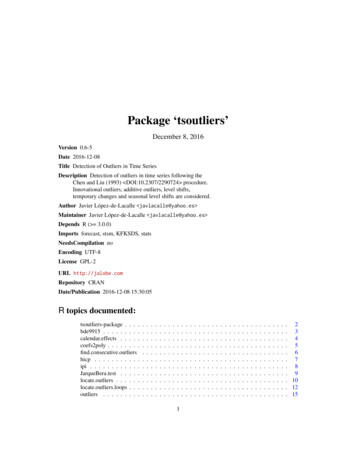
Transcription
Package ‘sf’June 13, 2020Version 0.9-4Title Simple Features for RDescription Support for simple features, a standardized way toencode spatial vector data. Binds to 'GDAL' for reading and writingdata, to 'GEOS' for geometrical operations, and to 'PROJ' forprojection conversions and datum transformations.License GPL-2 MIT file LICENSEURL https://r-spatial.github.io/sf/, https://github.com/r-spatial/sf/BugReports https://github.com/r-spatial/sf/issues/Depends methods, R ( 3.3.0)Imports classInt ( 0.4-1), DBI ( 0.8), graphics, grDevices, grid,magrittr, Rcpp ( 0.12.18), stats, tools, units ( 0.6-0),utilsSuggests blob, covr, dplyr ( 0.8-3), ggplot2, knitr, lwgeom ( 0.2-1), maps, mapview, microbenchmark, odbc, pillar, pool,raster, rgdal, rgeos, rlang, rmarkdown, RPostgres ( 1.1.0),RPostgreSQL, RSQLite, sp ( 1.2-4), spatstat, spatstat.utils,stars ( 0.2-0), testthat, tibble ( 1.4.1), tidyr ( 1.0-0), tidyselect ( 1.0.0), tmap ( 2.0), vctrsLinkingTo RcppVignetteBuilder knitrEncoding UTF-8RoxygenNote 7.1.0SystemRequirements C 11, GDAL ( 2.0.1), GEOS ( 3.4.0), PROJ ( 4.8.0)Collate 'RcppExports.R' 'init.R' 'crs.R' 'bbox.R' 'read.R' 'db.R''sfc.R' 'sfg.R' 'sf.R' 'bind.R' 'wkb.R' 'wkt.R' 'plot.R''geom.R' 'transform.R' 'sp.R' 'grid.R' 'arith.R' 'tidyverse.R''tidyverse-vctrs.R' 'cast sfg.R' 'cast sfc.R' 'graticule.R''datasets.R' 'aggregate.R' 'agr.R' 'maps.R' 'join.R' 'sample.R''valid.R' 'collection extract.R' 'jitter.R' 'sgbp.R'1
R topics documented:2'spatstat.R' 'stars.R' 'crop.R' 'gdal utils.R' 'nearest.R''normalize.R' 'defunct.R' 'z range.R' 'm range.R''shift longitude.R' 'make grid.R'NeedsCompilation yesAuthor Edzer Pebesma [aut, cre] ( https://orcid.org/0000-0001-8049-7069 ),Roger Bivand [ctb] ( https://orcid.org/0000-0003-2392-6140 ),Etienne Racine [ctb],Michael Sumner [ctb],Ian Cook [ctb],Tim Keitt [ctb],Robin Lovelace [ctb],Hadley Wickham [ctb],Jeroen Ooms [ctb] ( https://orcid.org/0000-0002-4035-0289 ),Kirill Müller [ctb],Thomas Lin Pedersen [ctb],Dan Baston [ctb]Maintainer Edzer Pebesma edzer.pebesma@uni-muenster.de Repository CRANDate/Publication 2020-06-13 00:00:03 UTCR topics documented:aggregate.sf . . . . . . . . . . . . . . . . . . .as . . . . . . . . . . . . . . . . . . . . . . . .bind . . . . . . . . . . . . . . . . . . . . . . .dbDataType,PostgreSQLConnection,sf-methoddb drivers . . . . . . . . . . . . . . . . . . . .extension map . . . . . . . . . . . . . . . . .gdal . . . . . . . . . . . . . . . . . . . . . . .gdal utils . . . . . . . . . . . . . . . . . . . .geos binary ops . . . . . . . . . . . . . . . .geos binary pred . . . . . . . . . . . . . . . .geos combine . . . . . . . . . . . . . . . . . .geos measures . . . . . . . . . . . . . . . . .geos query . . . . . . . . . . . . . . . . . . .geos unary . . . . . . . . . . . . . . . . . . .internal . . . . . . . . . . . . . . . . . . . . .is driver available . . . . . . . . . . . . . . .is driver can . . . . . . . . . . . . . . . . . .is geometry column . . . . . . . . . . . . . .merge.sf . . . . . . . . . . . . . . . . . . . . .nc . . . . . . . . . . . . . . . . . . . . . . . .Ops . . . . . . . . . . . . . . . . . . . . . . .plot . . . . . . . . . . . . . . . . . . . . . . .prefix map . . . . . . . . . . . . . . . . . . .rawToHex . . . . . . . . . . . . . . . . . . . .45678891113151718202125262627272828293535
R topics documented:sf . . . . . . . . . .sf-defunct . . . . . .sfc . . . . . . . . . .sf extSoftVersion . .sf project . . . . . .sgbp . . . . . . . . .st . . . . . . . . . . .stars . . . . . . . . .st agr . . . . . . . .st as binary . . . . .st as grob . . . . . .st as sf . . . . . . .st as sfc . . . . . . .st as text . . . . . .st bbox . . . . . . .st cast . . . . . . . .st cast sfc default .st collection extractst coordinates . . . .st crop . . . . . . . .st crs . . . . . . . .st drivers . . . . . .st geometry . . . . .st geometry type . .st graticule . . . . .st interpolate aw . .st is . . . . . . . . .st is longlat . . . . .st jitter . . . . . . .st join . . . . . . . .st layers . . . . . . .st line sample . . .st make grid . . . .st m range . . . . .st nearest feature . .st nearest points . .st normalize . . . . .st precision . . . . .st read . . . . . . . .st relate . . . . . . .st sample . . . . . .st shift longitude . .st transform . . . . .st viewport . . . . .st write . . . . . . .st zm . . . . . . . .st z range . . . . . .summary.sfc . . . . 86970717272737575767780818283848889919294959899101
4aggregate.sftibble . . .tidyverse . .transform.sfvalid . . . .vctrs . . . .Indexaggregate.sf101102106107108110aggregate an sf objectDescriptionaggregate an sf object, possibly union-ing geometriesUsage## S3 method for class 'sf'aggregate(x,by,FUN,.,do union TRUE,simplify TRUE,join st intersects)Argumentsxobject of class sfbyeither a list of grouping vectors with length equal to nrow(x) (see aggregate), oran object of class sf or sfc with geometries that are used to generate groupings,using the binary predicate specified by the argument joinFUNfunction passed on to aggregate, in case ids was specified and attributes need tobe grouped.arguments passed on to FUNdo unionlogical; should grouped geometries be unioned using st union? See details.simplifylogical; see aggregatejoinlogical spatial predicate function to use if by is a simple features object or geometry; see st joinDetailsIn case do union is FALSE, aggregate will simply combine geometries using c.sfg. When polygons sharing a boundary are combined, this leads to geometries that are invalid; see https://github.com/r-spatial/sf/issues/681.
as5Valuean sf object with aggregated attributes and geometries; additional grouping variables having thenames of names(ids) or are named Group.i for ids[[i]]; see aggregate.NoteDoes not work using the formula notation involving defined in aggregate.Examplesm1 cbind(c(0, 0, 1, 0), c(0, 1, 1, 0))m2 cbind(c(0, 1, 1, 0), c(0, 0, 1, 0))pol st sfc(st polygon(list(m1)), st polygon(list(m2)))set.seed(1985)d data.frame(matrix(runif(15), ncol 3))p st as sf(x d, coords 1:2)plot(pol)plot(p, add TRUE)(p ag1 aggregate(p, pol, mean))plot(p ag1) # geometry same as pol# works when x overlaps multiple objects in 'by':p buff st buffer(p, 0.2)plot(p buff, add TRUE)(p ag2 aggregate(p buff, pol, mean)) # increased mean of second# with non-matching featuresm3 cbind(c(0, 0, -0.1, 0), c(0, 0.1, 0.1, 0))pol st sfc(st polygon(list(m3)), st polygon(list(m1)), st polygon(list(m2)))(p ag3 aggregate(p, pol, mean))plot(p ag3)# In case we need to pass an argument to the join function:(p ag4 aggregate(p, pol, mean,join function(x, y) st is within distance(x, y, dist 0.3)))asMethods to coerce simpleSpatial*DataFrame objectsfeaturestoSpatial*andDescriptionas Spatial() allows to convert sf and sfc to Spatial*DataFrame and Spatial* for sp compatibility. You can also use as(x,"Spatial") To transform sp objects to sf and sfc with as(x,"sf").Usageas Spatial(from, cast TRUE, IDs paste0("ID", 1:length(from)))
6bindArgumentsfromobject of class sf, sfc POINT, sfc MULTIPOINT, sfc LINESTRING, sfc MULTILINESTRING,sfc POLYGON, or sfc MULTIPOLYGON.castlogical; if TRUE, st cast() from before converting, so that e.g. GEOMETRY objects with a mix of POLYGON and MULTIPOLYGON are cast to MULTIPOLYGON.IDscharacter vector with IDs for the Spatial* geometriesDetailsPackage sp supports three dimensions for POINT and MULTIPOINT (SpatialPoint*). Other geometries must be two-dimensional (XY). Dimensions can be dropped using st zm() with what "M" orwhat "ZM".For converting simple features (i.e., sf objects) to their Spatial counterpart, use as(obj,"Spatial")Valuegeometry-only object deriving from Spatial, of the appropriate classExamplesnc - st read(system.file("shape/nc.shp", package "sf"))# convert to SpatialPolygonsDataFramespdf - as Spatial(nc)# identical tospdf - as(nc, "Spatial")# convert to SpatialPolygonsas(st geometry(nc), "Spatial")# back to sfas(spdf, "sf")bindBind rows (features) of sf objectsDescriptionBind rows (features) of sf objectsBind columns (variables) of sf objectsUsage## S3 method for class 'sf'rbind(., deparse.level 1)## S3 method for class 'sf'cbind(., deparse.level 1, sf column name NULL)st bind cols(.)
s.objects to bind; note that for the rbind and cbind methods, all objects have to beof class sf; see dotsMethodsdeparse.levelinteger; see rbindsf column name character; specifies active geometry; passed on to st sfDetailsboth rbind and cbind have non-standard method dispatch (see cbind): the rbind or cbind methodfor sf objects is only called when all arguments to be binded are of class sf.If you need to cbind e.g. a data.frame to an sf, use data.frame directly and use st sf on its result,or use bind cols; see examples.st bind cols is deprecated; use cbind instead.Valuecbind called with multiple sf objects warns about multiple geometry columns present when thegeometry column to use is not specified by using argument sf column name; see also st sf.Examplescrs st crs(3857)a st sf(a 1, geom st sfc(st point(0:1)), crs crs)b st sf(a 1, geom st sfc(st linestring(matrix(1:4,2))), crs crs)c st sf(a 4, geom st sfc(st multilinestring(list(matrix(1:4,2)))), crs d(a,b,c) # warnsif (require(dplyr))dplyr::bind cols(a,b)c st sf(a 4, geomc st sfc(st multilinestring(list(matrix(1:4,2)))), crs crs)cbind(a,b,c, sf column name "geomc")df data.frame(x 3)st sf(data.frame(c, df))dplyr::bind cols(c, ine database type for R vectorDescriptionDetermine database type for R vectorDetermine database type for R vector
8extension mapUsage## S4 method for signature 'PostgreSQLConnection,sf'dbDataType(dbObj, obj)## S4 method for signature 'DBIObject,sf'dbDataType(dbObj, obj)ArgumentsdbObjDBIObject driver or connection.objObject to convertdb driversDrivers for which update should be TRUE by defaultDescriptionDrivers for which update should be TRUE by defaultUsagedb driversFormatAn object of class character of length 12.extension mapMap extension to driverDescriptionMap extension to driverUsageextension mapFormatAn object of class list of length 25.
gdal9gdalfunctions to interact with gdal not meant to be called directly by users(but e.g. by stars::read stars)Descriptionfunctions to interact with gdal not meant to be called directly by users (but e.g. by stars::read stars)Usagegdal read(x,.,options character(0),driver character(0),read data TRUE,NA value NA real ,RasterIO parameters list())gdal write(x,.,file,driver "GTiff",options character(0),type "Float32",NA value NA real ,geotransform,update FALSE)gdal inv geotransform(gt)gdal crs(file, options character(0))gdal metadata(file,domain item character(0),options character(0),parse TRUE)gdal subdatasets(file, options character(0), name TRUE)gdal polygonize(x,
10gdal)mask NULL,file tempfile(),driver "GTiff",use integer TRUE,geotransform,breaks )) brks,use contours FALSE,contour lines FALSE,connect8 FALSE,.gdal rasterize(sf, x, gt, file, driver "GTiff", options character())Argumentsxcharacter vector, possibly of length larger than 1 when more than one raster isread.ignoredoptionscharacter; raster layer read optionsdrivercharacter; when empty vector, driver is auto-detected.read datalogical; if FALSE, only the imagery metadata is returnedNA value(double) non-NA value to use for missing values; if NA, when writing missing values are not specially flagged in output dataset, when reading the default(dataset) missing values are used (if present / set).RasterIO parameterslist with named parameters to GDAL’s RasterIO; see the stars::read stars documentation.filecharacter; file nametypegdal write typegeotransformlength 6 numeric vector with GDAL geotransform parameters.updatelogical; TRUE if in an existing raster file pixel values shall be updated.gtdouble vector of length 6domain itemcharacter vector of length 0, 1 (with domain), or 2 (with domain and item); use"" for the default domain, use NA character to query the domain names.parselogical; should metadata be parsed into a named list (TRUE) or returned as character data?namelogical; retrieve name of subdataset? If FALSE, retrieve descriptionmaskstars object with NA mask (0 where NA), or NULLuse integerboolean; if TRUE, raster values are read as (and rounded to) unsigned 32-bitintegers values; if FALSE they are read as 32-bit floating points numbers. Theformer is supposedly faster.breaksnumeric vector with break values for contour polygons (or lines)
gdal utils11use contourslogical;contour lineslogical;connect8logical; if TRUE use 8 connection algorithm, rather than 4sfobject of class sfDetailsThese functions are exported for the single purpose of being used by package stars, they are notmeant to be used directly and may change or disappear without prior notice or deprecation warnings.gdal inv geotransform returns the inverse geotransformgdal crs reads coordinate reference system from GDAL data setget metadata gets metadata of a raster layergdal subdatasets returns the subdatasets of a gdal datasetValueobject of class crs, see st crs.named list with metadata itemsgdal subdatasets returns a zero-length list if file does not have subdatasets, and else a namedlist with subdatasets.Examples## Not run:f system.file("tif/L7 ETMs.tif", package "stars")f system.file("nc/avhrr-only-v2.19810901.nc", package "stars")gdal metadata(f)gdal metadata(f, NA character )try(gdal metadata(f, "wrongDomain"))gdal metadata(f, c("", "AREA OR POINT"))## End(Not run)gdal utilsNative interface to gdal utilsDescriptionNative interface to gdal utils
12gdal utilsUsagegdal utils(util "info",source,destination,options character(0),quiet FALSE,processing character(0),colorfilename character(0))Argumentsutilcharacter; one of info, warp, rasterize, translate, vectortranslate (forogr2ogr), buildvrt, demprocessing, nearblack, gridsourcecharacter; name of input layer(s); for warp or buidvrt this can be more thanonedestinationcharacter; name of output layeroptionscharacter; raster layer read optionsquietlogical; if TRUE, suppress printing of output for infoprocessingcharacter; processing options for demprocessingcolorfilenamecharacter; name of color file for demprocessing (mandatory if processing "color-relief")Valueinfo returns a character vector with the raster metadata; all other utils return (invisibly) a logicalindicating success (i.e., TRUE); in case of failure, an error is raised.Examplesif (sf extSoftVersion()["GDAL"] "2.1.0") {# info utils can be used to list information about about a raster# dataset. More info: https://gdal.org/programs/gdalinfo.htmlin file - system.file("tif/geomatrix.tif", package "sf")gdal utils("info", in file, options c("-mm", "-proj4"))# vectortranslate utils can be used to convert simple features data between# file formats. More info: https://gdal.org/programs/ogr2ogr.htmlin file - system.file("shape/storms xyz.shp", package "sf")out file - paste0(tempfile(), ".gpkg")gdal utils(util "vectortranslate",source in file,destination out file, # output format must be specified for GDAL 2.3options c("-f", "GPKG"))# The parameters can be specified as c("name") or c("name", "value"). The
geos binary ops13# vectortranslate utils can perform also various operations during the# conversion process. For example we can reproject the features during the# translation.gdal utils(util "vectortranslate",source in file,destination out file,options c("-f", "GPKG", # output file format for GDAL 2.3"-s srs", "EPSG:4326", # input file SRS"-t srs", "EPSG:2264", # output file SRS"-overwrite"))st read(out file)# The parameter s srs had to be specified because, in this case, the in file# has no associated SRS.st read(in file)}geos binary opsGeometric operations on pairs of simple feature geometry setsDescriptionPerform geometric set operations with simple feature geometry collectionsUsagest intersection(x, y)## S3 method for class 'sfc'st intersection(x, y)## S3 method for class 'sf'st intersection(x, y)st difference(x, y)## S3 method for class 'sfc'st difference(x, y)st sym difference(x, y)st snap(x, y, tolerance)
14geos binary opsArgumentsxobject of class sf, sfc or sfgyobject of class sf, sfc or sfgtolerancetolerance values used for st snap; numeric value or object of class units; mayhave tolerance values for each feature in xDetailsA spatial index is built on argument x; see ml. The reference for the STR tree algorithm is: Leutenegger, Scott T., Mario A. Lopez, and Jeffrey Edgington. "STR: A simple and efficient algorithm for R-tree packing." Data Engineering,1997. Proceedings. 13th international conference on. IEEE, 1997. For the pdf, search GoogleScholar.When called with missing y, the sfc method for st intersection returns all non-empty intersections of the geometries of x; an attribute idx contains a list-column with the indexes of contributinggeometries.when called with a missing y, the sf method for st intersection returns an sf object with attributes taken from the contributing feature with lowest index; two fields are added: n.overlapswith the number of overlapping features in x, and a list-column origins with indexes of all overlapping features.When st difference is called with a single argument, overlapping areas are erased from geometries that are indexed at greater numbers in the argument to x; geometries that are empty or containedfully inside geometries with higher priority are removed entirely. The st difference.sfc methodwith a single argument returns an object with an "idx" attribute with the orginal index for returnedgeometries.ValueThe intersection, difference or symmetric difference between two sets of geometries. The returnedobject has the same class as that of the first argument (x) with the non-empty geometries resultingfrom applying the operation to all geometry pairs in x and y. In case x is of class sf, the matchingattributes of the original object(s) are added. The sfc geometry list-column returned carries anattribute idx, which is an n-by-2 matrix with every row the index of the corresponding entries of xand y, respectively.NoteTo find whether pairs of simple feature geometries intersect, use the function st intersects instead of st intersection.See Alsost union for the union of simple features collections; intersect and setdiff for the base R set operations.
geos binary pred15Examplesset.seed(131)library(sf)m rbind(c(0,0), c(1,0), c(1,1), c(0,1), c(0,0))p st polygon(list(m))n 100l vector("list", n)for (i in 1:n)l[[i]] p 10 * runif(2)s st sfc(l)plot(s, col sf.colors(categorical TRUE, alpha .5))title("overlapping squares")d st difference(s) # sequential differences: s1, s2-s1, s3-s2-s1, .plot(d, col sf.colors(categorical TRUE, alpha .5))title("non-overlapping differences")i st intersection(s) # all intersectionsplot(i, col sf.colors(categorical TRUE, alpha .5))title("non-overlapping intersections")summary(lengths(st overlaps(s, s))) # includes self-counts!summary(lengths(st overlaps(d, d)))summary(lengths(st overlaps(i, i)))sf st sf(s)i st intersection(sf) # all intersectionsplot(i["n.overlaps"])summary(i n.overlaps - lengths(i origins))# A helper function that erases all of y from x:st erase function(x, y) st difference(x, st union(st combine(y)))geos binary predGeometric binary predicates on pairs of simple feature geometry setsDescriptionGeometric binary predicates on pairs of simple feature geometry setsUsagest intersects(x, y, sparse TRUE, .)st disjoint(x, y x, sparse TRUE, prepared TRUE)st touches(x, y, sparse TRUE, prepared TRUE)st crosses(x, y, sparse TRUE, prepared TRUE)st within(x, y, sparse TRUE, prepared TRUE)st contains(x, y, sparse TRUE, prepared TRUE)
16geos binary predst contains properly(x, y, sparse TRUE, prepared TRUE)st overlaps(x, y, sparse TRUE, prepared TRUE)st equals(x, y, sparse TRUE, prepared FALSE)st covers(x, y, sparse TRUE, prepared TRUE)st covered by(x, y, sparse TRUE, prepared TRUE)st equals exact(x, y, par, sparse TRUE, prepared FALSE)st is within distance(x, y, dist, sparse TRUE)Argumentsxobject of class sf, sfc or sfgyobject of class sf, sfc or sfg; if missing, x is usedsparselogical; should a sparse index list be returned (TRUE) or a dense logical matrix?See below.ignoredpreparedlogical; prepare geometry for x, before looping over y? See Details.parnumeric; parameter used for "equals exact" (margin);distdistance threshold; geometry indexes with distances smaller or equal to thisvalue are returned; numeric value or units value having distance units.DetailsIf prepared is TRUE, and x contains POINT geometries and y contains polygons, then the polygongeometries are prepared, rather than the points.For most predicates, a spatial index is built on argument x; see ml. Specifically, st intersects, st disjoint, st touches st crosses,st within, st contains, st contains properly, st overlaps, st equals, st covers andst covered by all build spatial indexes for more efficient geometry calculations. st relate,st equals exact, and st is within distance do not.If y is missing, ‘st predicate(x, x)‘ is effectively called, and a square matrix is returned with diagonal elements ‘st predicate(x[i], x[i])‘.Sparse geometry binary predicate (sgbp) lists have the following attributes: region.id with therow.names of x (if any, else 1:n), ncol with the number of features in y, and predicate with thename of the predicate used.‘st contains properly(A,B)‘ is true if A intersects B’s interior, but not its edges or exterior; Acontains A, but A does not properly contain A.See also st relate and https://en.wikipedia.org/wiki/DE-9IM for a more detailed descriptionof the underlying algorithms.st equals exact returns true for two geometries of the same type and their vertices correspondingby index are equal up to a specified tolerance.
geos combine17ValueIf sparse FALSE, st predicate (with predicate e.g. "intersects") returns a dense logical matrixwith element i,j TRUE when predicate(x[i],y[j]) (e.g., when geometry of feature i and j intersect); if sparse TRUE, an object of class sgbp with a sparse list representation of the same matrix,with list element i an integer vector with all indices j for which predicate(x[i],y[j]) is TRUE(and hence integer(0) if none of them is TRUE). From the dense matrix, one can find out if one ormore elements intersect by apply(mat,1,any), and from the sparse list by lengths(lst) 0, seeexamples below.NoteFor intersection on pairs of simple feature geometries, use the function st intersection insteadof st intersects.Examplespts st sfc(st point(c(.5,.5)), st point(c(1.5, 1.5)), st point(c(2.5, 2.5)))pol st polygon(list(rbind(c(0,0), c(2,0), c(2,2), c(0,2), c(0,0))))(lst st intersects(pts, pol))(mat st intersects(pts, pol, sparse FALSE))# which points fall inside a polygon?apply(mat, 1, any)lengths(lst) 0# which points fall inside the first polygon?st intersects(pol, pts)[[1]]geos combineCombine or union feature geometriesDescriptionCombine several feature geometries into one, without unioning or resolving internal boundariesUsagest combine(x)st union(x, y, ., by feature FALSE)Argumentsxobject of class sf, sfc or sfgyobject of class sf, sfc or sfg (optional).ignoredby featurelogical; if TRUE, union each feature, if FALSE return a single feature that is thegeometric union of the set of features
18geos measuresDetailsst combine combines geometries without resolving borders, using c.sfg (analogous to c for ordinary vectors).If st union is called with a single argument, x, (with y missing) and by feature is FALSE all geometries are unioned together and an sfg or single-geometry sfc object is returned. If by featureis TRUE each feature geometry is unioned. This can for instance be used to resolve internal boundaries after polygons were combined using st combine. If y is provided, all elements of x and yare unioned, pairwise (and by feature is ignored). The former corresponds to gUnaryUnion, thelatter to gUnion.Unioning a set of overlapping polygons has the effect of merging the areas (i.e. the same effect asiteratively unioning all individual polygons together). Unioning a set of LineStrings has the effectof fully noding and dissolving the input linework. In this context "fully noded" means that therewill be a node or endpoint in the output for every endpoint or line segment crossing in the input."Dissolved" means that any duplicate (e.g. coincident) line segments or portions of line segmentswill be reduced to a single line segment in the output. Unioning a set of Points has the effect ofmerging all identical points (producing a set with no duplicates).Valuest combine returns a single, combined geometry, with no resolved boundaries; returned geometriesmay well be invalid.If y is missing, st union(x) returns a single geometry with resolved boundaries, else the geometries for all unioned pairs of x[i] and y[j].See Alsost intersection, st difference, st sym differenceExamplesnc st read(system.file("shape/nc.shp", package "sf"))st combine(nc)plot(st union(nc))geos measuresCompute geometric measurementsDescriptionCompute Euclidian or great circle distance between pairs of geometries; compute, the area or thelength of a set of geometries.
geos measures19Usagest area(x, .)st length(x)st distance(x,y,.,dist fun,by element FALSE,which ifelse(isTRUE(st is longlat(x)), "Great Circle", "Euclidean"),par 0,tolerance 0)Argumentsxobject of class sf, sfc or sfg.ignoredyobject of class sf, sfc or sfg, defaults to xdist fundeprecatedby elementlogical; if TRUE, return a vector with distance between the first elements of x andy, the second, etc. if FALSE, return the dense matrix with all pairwise distances.whichcharacter; for Cartesian coordinates only: one of Euclidean, Hausdorff orFrechet; for geodetic coordinates, great circle distances are computed; see detailsparfor which equal to Hausdorff or Frechet, optionally use a value between 0 and1 to densify the geometrytoleranceignored if st is longlat(x) is FALSE; otherwise, if set to a positive value, thefirst distance smaller than tolerance will be returned, and true distance may besmaller; this may speed up computation. In meters, or a units object convertibleto meters.Detailsgreat circle distance calculations use function geod inverse from PROJ; see Karney, Charles FF,2013, Algorithms for geodesics, Journal of Geodesy 87(1), 43–55ValueIf the coordinate reference system of x was set, these functions return values with unit of measurement; see set units.st area returns the area of a geometry, in the coordinate reference system used; in case x is indegrees longitude/latitude, st geod area is used for area calculation.
20geos queryst length returns the length of a LINESTRING or MULTILINESTRING geometry, using the coordinatereference system. POINT, MULTIPOINT, POLYGON or MULTIPOLYGON geometries return zero.If by element is FALSE st distance returns a dense numeric matrix of dimension l
sf_column_name character; specifies active geometry; passed on tost_sf Details both rbind and cbind have non-standard method dispatch (seecbind): the rbind or cbind method for sf objects is only called when all arguments to be binded are of class sf. If you need to cbind e.g. a data.frame to an sf, usedata.framedirectly and usest_sfon its result,










